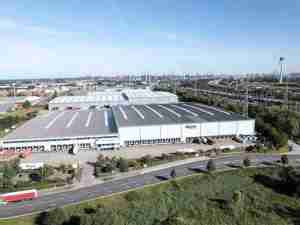A challenge for the port and initial experience from Norway
At the Überseebrücke pier, the Port of Hamburg has for the first time been able to welcome an LNG-fuelled ship. The KV BARENTSHAV belongs to the Norwegian Coastguard fleet, and is deployed on fisheries controls, sea rescue, policing, Customs inspections and environmental checks within Norwegian territorial waters. The speciality of the ship is its environmentally friendly driven motor: Instead of diesel fuel the KV BARENTSHAV is powered in normal conditions by Liquefied Natural Gas (LNG). The occasion for the ship’s visit between 19 and 21 June 2012 was the “LNG – the Norwegian Experience” conference of experts organized in Hamburg by the German-Norwegian Chamber of Commerce along with Innovation Norway and the classification society DNV Germany.
Propulsion of the KV BARENTSHAV is through a propeller, driven mechanically either via the main engine or a gas-fuelled electric motor. Two engine-rooms and tanks are available for this, one for diesel propulsion and one for gas operation using LNG. The four gas-fuelled engines producing power for the electric motor start and stop automatically, depending on the power requirement. The diesel engine only comes into use for towing assignments and special runs at high speeds of up to 20 knots. The 93.0 metres long and 16.6 metres beamy ship displaces 4000 tons (grt) and with a bollard pull of 100 tons is capable of holding steady a 150,000-ton tanker during a storm.
Against the background of environmentally friendlier shipping, LNG plays an important part, as natural gas propulsion reduces the quantity of nitrous gases by almost 90 percent by comparison to diesel fuel and of carbon dioxide by up to 20 percent. Sulphur dioxide and dust particle emissions become almost non-existent. In addition, engine wear and hence operating costs are reduced. As a result of the arrangements applying from 2015 under the regulations imposing ceilings on sulphur emissions in SECA areas (Sulphur Emission Control Areas), among these the North Sea and the Baltic, the shipping industry has stepped up its search for alternative fuels.
Hamburg has recognized the importance of the alternative fuel that makes sense both commercially and ecologically. The Hamburg Port Authority and Linde Group want to promote the use of LNG and are at present compiling a feasibility study on the commercial use of LNG in the Port of Hamburg. The findings of this research could be used for making a start on concrete infrastructure projects such as an LNG bunkering facility in the Port of Hamburg. “The Port of Hamburg should be a leader for environmental friendliness and efficiency. In future propulsion systems using liquefied natural gas should be playing a part here. In worldwide cooperation we now need to create the standards and the foundations for the essential infrastructure. The Port of Hamburg performs an immensely important role as a feeder port for the Baltic and consequently we are working on the essential preliminaries for the LNG infrastructure needed in Hamburg. We are also looking into equipping newbuildings for our own fleet with LNG technology,” says HPA Managing Director Jens Meier.
To learn from the experiences of the pioneer in building and operating LNG-powered ships, the Port of Hamburg is communicating with experts from Norway. Norway has had gas-powered ferries for over ten years, also the necessary infrastructure for fuelling ships of this type. The appropriate regulations for the use of LNG have also been issued for the region. 14 Norwegian terminals have been designed for the storage of LNG as a marine fuel, and four of these are already in use as bunkering stations. The German-Norwegian Chamber of Commerce champions the promotion of bilateral trade relations and investments between Germany and Norway. “Shipping has a green future. Norway is the worldwide leader in that field. Germany cannot miss the boat here and can learn a lot from Norway. We see it as our task to act as intermediary between the tw









